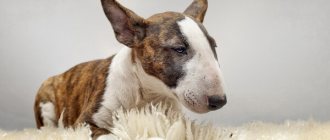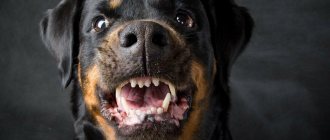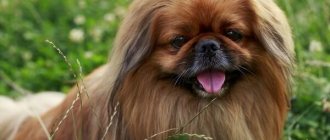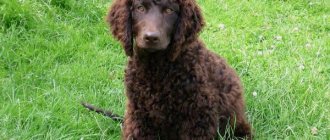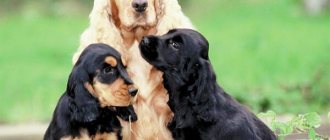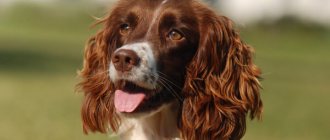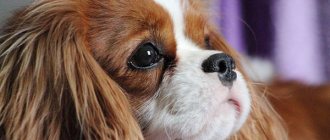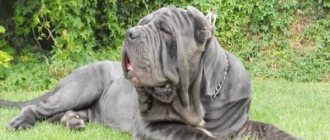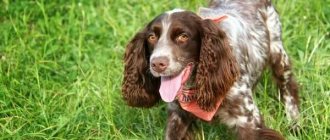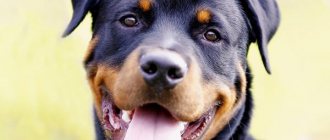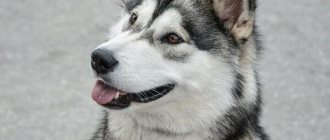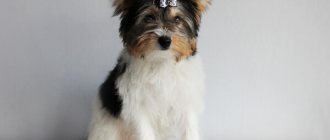Spaniels are a large group of breeds that include both hunting and decorative and even dwarf dogs.
Cocker spaniels are dogs bred exclusively for hunting.
But over time, the popularity of the breed grew and people of all ages and professions began to have its representatives as companions, faithful companions and devoted friends.
Increasingly, cocker spaniels are becoming not hunters, but full members of the family and winners of dog shows.
Origin story and what it looks like in the photo
The first mention of spaniels dates back to around the 16th century, and the name of the breed comes from the word espaigneul, which meant “Spanish dog” in Old French..
Despite this, there is no consensus about the homeland of these dogs. There are several versions of the origin of spaniels: Greek, Spanish, German, Irish; descriptions of similar animals were found in artifacts of the Cypriot and Egyptian civilizations.
The final formation of the breed of hunting cocker spaniels is the merit of British breeders. It was in England in the 19th century. a male named Obo gave birth to offspring with endurance, hunting instincts and courage.
The primary purpose of these dogs was to hunt small birds and animals; it was the hunting instinct, activity and ability to lift birds from water and land that determined the popularity of English cockers.
The first exhibition at which English cocker spaniels were presented was held in 1859 in Birmingham, but the breed was not recognized as an independent breed until 1892, when it was registered by the English Kennel Club.
The breed was officially registered with the FCI only in 1902.
Until 1990, the breed standard adhered to strict limits and individuals with even minor deviations were rejected, excluded from breeding and were not able to participate in exhibitions.
A little later, the standard was relaxed and now cocker spaniels are used not only for hunting, but also as companions.
Maintenance and care
As with any other breed, individuals need to be looked after. Brush the coat regularly and have it trimmed by a groomer. A pet that has not been cut for a long time will look untidy. The specialist will perform a haircut using a clipper and can also create various hairstyles.
Exercise regularly to keep your pets fit and avoid gaining weight. In addition, feed them with high-quality food that meets all their needs. Set up a mini area for them to sleep comfortably.
Dogs need to be brushed every day and examined at the same time. Don't let their long hairs get tangled.
Because of the shape of the ears, air cannot circulate in them as well as it should. Often, moisture gets trapped in the inner ear, creating the perfect environment for yeast infections to spread. Therefore, if the animal gets wet or you have given it a bath, check your pet's ears. They must be dry.
Another peculiarity is that dogs are susceptible to eye diseases. Check and clean your dogs eyes regularly.
To ensure your pet's well-being during the cold season, purchase a jumpsuit for him. You can also find dog clothing patterns online.
Interesting Facts
- The name "cocker" comes from the English word "woodcock" - forest bird (woodcock). It was this feathered game that was hunted by the first representatives of the breed.
- These dogs are often used by law enforcement agencies to search for drugs and other illegal substances.
- The writer Mikhail Prishvin had 4 spaniels.
- The children's book “Tomka” by Evgeny Charushin is dedicated to a spaniel puppy.
How long do Russian spaniels live or how to extend the life of a little hunter?
The Russian spaniel is considered the pride of Russian dog breeders. He has an expressive appearance, a sociable and friendly character, and excellent instincts.
The average life expectancy of the breed is longer than that of other hunting dogs. Despite this, owners always want their dog to live even longer.
We will tell you in detail how to properly care for your pet in order to prolong its life, and we will also look at how to avoid the accidental death of a dog.
Description and standard
English cocker spaniels are dogs with a harmonious build; they have a squat, compact, proportionally built body with well-developed muscles..
Representatives of this breed are very graceful; they move at a light gallop, smoothly and gracefully, as if without touching the surface with their paws.
According to the official standard they have:
- oval head with a pronounced transition to an almost square muzzle;
- scissor bite;
- limbs are straight, strong, with well-developed muscles, well covered with hair;
- the back is straight, the croup is massive and short;
- chest of moderate depth;
- the ears are oval, long and wide, hanging, set low, close to the head, the base of the auricle is located at eye level, the outer side is covered with wavy thick hair;
- the eyes are round, shallow-set, but not bulging, the iris is dark brown;
- the nose is oval, pigmented black, the nostrils are wide;
- The tail is saber-shaped, set below the level of the back, docked, but can also have a natural length to the hocks, since this procedure is prohibited in a number of countries.
The coat of English Cocker Spaniels is thick, close-lying, soft and silky . Can be straight or slightly wavy, but not curly. The undercoat is dense and well developed.
Character of the English Cocker Spaniel
A child plays with English cocker spaniels.
English cocker spaniels are inquisitive, self-aware nimble dogs with a friendly, but not at all weak, character. They will value and obey the owner by default, but they will not allow the rest of the household to manipulate them. Moreover, when trying to force your pet to do something, be prepared to observe stubbornness and skillful imitation of misunderstanding. If we talk about respect, then first of all the dog feels it towards the owner, and secondly – towards itself. Children in this hierarchical pyramid occupy the penultimate step. Yes, the “English” play with them with pleasure, but do not expect angelic patience and iron endurance from the dog when the child begins to cause serious discomfort or pain to it.
Most cockers are peaceful and accommodating (exceptions are also possible), so adding cats and other dogs to them is quite acceptable. But in the case of birds, not everything is so smooth. Left alone with canaries, parrots or chickens, a pet is unlikely to cope with the temptation to hone its hunting techniques on them. The call of the ancestors - nothing can be done. In the games, the “English” are like Nancy Drew in dog form. Possessing an excellent sense of smell (American cockers are resting) and excellent eyesight, they love to play detective and look for seemingly forever lost objects. While walking, most individuals turn on the “excavator” mode and begin to excavate flower beds and sandy hills, which looks very funny from the outside.
As for temperament, inside every English cocker spaniel there lives a restless party animal who despises regularity and imposingness. These long-eared livelies are sincerely happy to have any company. Moreover, the more participants there are, the better, because doggies really love to play in public. Born tacticians and psychologists, the “English” will always find a way to squeeze into even the least friendly dog team and gain a foothold in it as a shaggy-haired entertainer.
Recently, more and more breeders have noted that English Cockers have a love of traveling on various types of transport. So, for example, taking advantage of the owner’s absent-mindedness, during a walk they can easily jump into a shuttle bus and drive off in an unknown direction. If you have your own car, your cocker spaniel will be happy to test its speed by lounging in the back seat and exposing its muzzle to the wind through the open window.
Happy paws
Character traits
Cocker spaniels are playful, responsive and cheerful dogs . Being active and sharp hunters, at home they are the embodiment of kindness and tenderness. They need love, attention and care.
Representatives of this breed are very good-natured and affectionate towards all family members, but, as a rule, they choose one person as the owner and remain faithful to him throughout his life, trying to always stay close and participate as much as possible in his life.
Such excessive attachment can lead to a loss of independence and an absolute inability to be alone.
Quiet and timid individuals are extremely rare among cockers; most often these dogs are sociable and inquisitive. At the same time, they are wary of strangers and loud barks notify their owners about the visit of strangers, which indicates a good guard instinct.
Despite the stubbornness inherent in these dogs and the habit of acting independently, they are smart, flexible and strive to please the owner, so there are no problems with their upbringing and training.
Expert opinion
Kozhevin Semyon Kirillovich
Expert dog handler.
Representatives of this breed are characterized by a strong attachment to their owner. They need his undivided attention and constant communication. If these traits are encouraged, the pet may completely lose independence and even a short stay alone will cause him suffering. It is important to remember this when raising a cocker, and to train him to have self-control and understanding that the owner cannot be around all the time.
Long-lived dogs
Despite statistics and calculations, nature never ceases to amaze; the Guinness Book of Records confirms this. On its pages there is data about long-lived dogs that have outlived their required age by more than 2 times:
- The first record-breaking pet was the Austrian shepherd, whose lifespan was more than 29 years. All his life the dog guarded sheep flocks and was active until his last days.
- Terrier Max is approaching his 30th birthday. The dog never received any care and ate regular food.
The length of a dog's life is individual, but the owner of the dog can make it long enough, happy, colorful!
Among some breeds there are real long-lived dogs. All other things being equal, a border collie, for example, will live longer than, say, a boxer or a great dane.
The Dachshund is the most famous, friendly hunting breed. The dachshund, despite its appearance, is a courageous, courageous, serious, purposeful, and independent dog. These funny little guys live up to 17 years on average, but sometimes reach the 20-year mark.
The main “danger zone” is a long spine, problems with intervertebral discs are possible; tend to be overweight, more often when they begin to age. These problems can be prevented by balanced exercise and a healthy diet.
Yorkshire Terrier: representatives of this, at first glance, small and weak decorative breed live on average 14-16 years, which is longer than huskies. The Yorkshire Terrier weighs 2-3 kilograms, but it is not fragile - they were previously used to exterminate rats.
This fact does not prevent their owners from decorating their pets with various bows and ribbons. The diseases to which Yorkies are susceptible are caused by “smallness.” This list includes non-overgrowth of the fontanel, cryptorchidism, Perthes disease, distichiasis.
An active and smart Beagle will not let its owner get bored. These cheerful and noisy pets live an average of 15 years. They have a good appetite, especially in adolescence (they eat whenever they see food), so they do not need to be overfed.
Obesity will not benefit the Beagle. Epilepsy is relatively common, but it can be successfully treated. Typical diseases of beagles are boils, glaucoma, and cataracts. Due to the long, flexible ears, the inner cavity does not receive sufficient ventilation, which will lead to infections.
Advantages and disadvantages
When thinking about buying a puppy, you should carefully read the advantages and disadvantages of the breed - this will help you make the right, informed decision.
The advantages of cocker spaniels include::
- activity;
- devotion;
- developed hunting and guard instincts;
- ability to get along with children;
- courage and endurance;
- playful disposition;
- mind;
- sociability;
- agreeableness;
- learning ability
Negative qualities of the breed:
- need for constant attention and communication;
- the need for active long walks;
- hyperactivity;
- tendency to obesity;
- heavy shedding;
- loud barking for any reason;
- stubbornness.
In addition, English Cocker Spaniels require careful and quite labor-intensive care for their ears and coat.
English Cocker Spaniel training
Hunting with an English Cocker Spaniel
In modern conditions, the “English” are gradually changing their qualifications, increasingly turning into sporting dogs and playful companions. However, the hunting instincts of the breed do not suffer from this situation. English cocker spaniels can work with both swamp and field or even upland game. However, taking into account the fact that each type of bird has its own odor, varying in intensity, it is unlikely to be possible to train a dog on both snipe and black grouse at once. Experienced owners recommend starting to introduce your pet to hunting with a wading bird. According to observations, a dog that deftly handles great snipes performs just as well when working with quails. At the same time, dogs, accustomed to lifting only wild animals onto their wings, slow down and get lost in wetlands.
The English Cocker Spaniel begins to be trained from an early age and in a playful way. For example, you can tie a bird's wing to a string and twitch it in front of a 3-month-old puppy's nose. The surprised animal will immediately try to grab the animated bunch of feathers, and your task is to allow him to do this. Just do not allow the puppy to chew the “prey”, since this habit will later be transferred to real hunting trophies. At 4 months, babies are trained to search for and present objects. The dog is allowed to sniff the bird carcass, after which they hide it in a secluded place and offer to find the missing one. At first, you can use hints - a hand gesture in the direction of an object or a deliberately created draft that carries the smell of game throughout the apartment.
Commands “Come to me!” and “Nearby!” in hunting dogs they must be practiced to the point of automatism, therefore the OKD completed before training is only beneficial for the English cocker. Another important skill is indifference to shots, which is the most difficult for the “English”. They begin to accustom their pet to the sharp sounds and smell of gunpowder in the field. First, shots are fired at a distance (the optimal distance is 150 m) and only after the dog gets used to the noise, the gap between the shooter and the animal is gradually reduced.
Important: in order to develop a clear understanding of your requirements and compliance in your English Cocker Spaniel, use only one prohibitive command out of several possible ones. Do not disorient the dog with the word “Ugh!” if before that he only heard from you “No!”
It is better to start getting acquainted with swamp game with great snipes, which fly quite low and heavily. Swamp hens are also a good target for an inexperienced cocker. In upland hunting, the optimal target will be a brood of grouse. As a rule, English cocker spaniels are not involved in working with waterfowl, but if you wish, it is also possible to train your pet for this type of game. Wait until mid-July, when the ducklings are grown but not fully fledged, and begin training. Well, an option for the most seasoned is hare hunting. Why specifically for the aged? Because spaniels love to chase their long-eared dogs aimlessly, in 99% of cases leaving the owner without prey.
Color variations
Cocker Spaniels have a variety of coat colors: they can be solid, spotted, tri-colored or speckled . Most often there are individuals with a coat of a solid monochromatic color.
Red or golden
Most often, the red coat color is monochromatic, but can be observed in the form of tan on other, darker colors. Pigmentation is brown or black.
Black
The coat is a solid jet black color , the nose, eyelids and claws are also pigmented black . This color is considered dominant. Possible red tan.
White
A solid snow-white color is extremely rare . Not all judges recognize this coat color of Cocker Spaniels as corresponding to the breed standard, so pure white dogs rarely take prizes.
Chocolate
Recessive trait. The coat is chocolate-colored, varying in color from milkier to richer dark chocolate. Pigmentation is brown. Possible subtle red or golden tan.
Brown
The coat is dark brown or walnut in color. The eyelids and nose are black or colored to match the coat.
Education and training
You won't be able to force a cocker to do exercises unless you get him interested. Think about training in a playful way. It should not be long and without the same commands, otherwise the dog will quickly get bored. With proper training, you will not spend a lot of time raising a cocker puppy.
At three months, teach your puppy etiquette around strangers. If you don’t know how to stop your child from asking for food, then the method is simple - ignore the pitiful hungry look. Otherwise, respect for you will end. Is it possible to be tough and tyrant? No, either, maintain a middle ground between excessive lisp and screaming.
At four months they will try to dominate you and take a leadership position in the house. Don't let your puppy drag you on a leash. How to train him to wear a collar - wear it discreetly while playing or eating.
At eight months, it is time for your spaniel to become well-mannered and trained. Classes are needed regardless of whether you are a hunter or not. The call command is required to be trained. Choose one of the commands "Ugh!" and “You can’t!” Teach your dog not to be afraid of gunshots if you plan to go hunting with him.
In the same case, start by training wading birds from childhood and teach them to search for objects at four months. Hide the game and offer to find it. In the summer, try hunting ducklings. During warm seasons, even in spring, do not practice in the heat. And in the fall and winter, exercise in any adequate weather. Let the student do his chores and take a walk first.
For inexperienced dog breeders, raising and training an English Cocker Spaniel can create difficulties - in this case, you can contact an instructor. This will solve all the problems that have arisen.
Looking for an English Cocker Spaniel? Find your pet from 2 offers As a gift
Is he good with children and does he get along with other pets?
Being active, good-natured and friendly dogs that are not prone to aggression, Cocker Spaniels even get along well with small children and enjoy spending time playing with them.
NOTE!
It is important to remember that these dogs are jealous of their things, especially toys, so you should explain to the child that you cannot take them away from the dog.
These dogs are born hunters and it is impossible to wean them from this . They see birds, rodents and cats only as prey and will always chase them.
If raised correctly, cockers can get along with cats, but only if they grew up together.
How to extend the life of your pet?
If you love your pet and want him to be with you for a long time, try to follow a few simple recommendations.
- Give him attention, play with him, walk him more often. Let him run around the yard, if possible, go out into nature with him on the weekend.
- Monitor your pet's diet. Dog food should be healthy and rich in biologically active substances that a spaniel needs. Consult your veterinarian for proper portion sizes for each meal to help prevent malnutrition or obesity.
- Equip your spaniel's sleeping area in such a way that it is protected from drafts.
- Check your dog's well-being regularly. Comprehensive vaccinations play a very important role in the spaniel’s health. Don’t forget to vaccinate your pet every year at your next veterinarian checkup. Unfortunately, there are currently constant mutations in the direction of strengthening pathogens of various diseases, and vaccinations are practically the only way to protect your dog.
How to properly care
Like representatives of other breeds, cocker spaniels need regular hygiene procedures, which should be taught to the puppy from an early age. The ears and coat of these dogs require especially careful care.
Wool and bathing
Cocker spaniels need to be brushed daily - this eliminates the possibility of matting of the coat and the appearance of tangles, and also helps to get rid of dead hair, which is especially important during seasonal shedding..
Grooming also involves regular haircuts and trimming. Having certain skills and experience, you can do them yourself, but it is better to contact a professional groomer.
CAREFULLY!
You can't cut the guard hair - after that it will lie incorrectly. You can only trim the hair on the tips of the ears, chest and paws.
You need to bathe your pet as it gets dirty, but at least once every 2 months - washing makes the coat of these dogs more beautiful and silky, while the skin does not dry out, since it is adapted to water.
For washing, you should use a special shampoo intended for long-haired dogs, and after bathing, you should thoroughly dry the dog's hair with a towel and hairdryer..
Eyes
Every 2-3 days, wipe with a cotton pad soaked in chamomile infusion and tea leaves.
Ears
Clean your ears weekly using a cotton swab and a special product, removing accumulated wax and dirt.
Every 2-3 months it is necessary to carefully trim the inside of the ear to improve ventilation.
Claws
With regular active walks on asphalt, the claws wear down on their own. In winter or if the pet often walks on non-hard surfaces, this does not happen and the claws must be trimmed with a guillotine nail clipper every 3-4 weeks.
Teeth
Brush with a special toothbrush and toothpaste every 2-3 days, and also give your pet chewable treats and toys that help mechanically clean the teeth of plaque and stones.
What does life expectancy depend on?
Factors that affect a pet's lifespan:
- Dog health. It is important to conduct regular (at least 2 times a year) preventive examination by a veterinarian. This becomes especially important when the pet reaches 7 years of age.
- Hereditary predisposition to diseases, the presence of genetic abnormalities.
- Quality of keeping and care of animals.
- Food quality.
- Force majeure situations. It is recommended to walk your dog on a leash.
It is better to walk your dog on a leash
Life expectancy, health and major diseases
With proper care and proper housing conditions, cocker spaniels live on average 10-15 years.
They have good health and good immunity, but there is a tendency to a number of acquired or hereditary diseases:
- asthenia;
- cataract;
- glaucoma;
- cherry eye;
- entropion of the eyelid;
- distichiasis;
- hip dysplasia;
- otitis;
- allergy;
- urolithiasis disease;
- melanoma;
- deafness;
- conjunctivitis;
- epilepsy;
- hydrocephalus;
- hepatitis;
- atopy;
- discopathy;
- perianal adenocarcinoma;
- obesity;
- melanoma;
- lipoma
In addition, representatives of this breed often have psychological problems - cocker spaniels are prone to hysteria, panic, and aggression.
Life expectancy at home
On average, spaniels live 12-14 years, but the variability of the period is determined by belonging to a particular breed. Each of them has a number of characteristics, including average life expectancy.
Lifespans of different types of spaniels
The spaniel family consists of more than ten varieties. The most popular (the approximate life expectancy of the breed is indicated in parentheses):
- American cocker (13-15 years old);
- English cocker (12-14 years old);
- Russian spaniel (14-15 years old);
- Irish Water Spaniel (10-12 years old);
- Clumber (13-15 years old);
- field (12-13 years old);
- King Charles (10-12 years old);
- Cavalier King Charles (12-13 years old);
- English springer (can live about 14 years);
- German Wachtelhund (about 13 years old).
On a note! Russian spaniels live longer than most hunting dogs, since the body of these animals wears out very slowly (this is a feature of the breed).
Irish Water Spaniel
Causes of premature death
An owner's life may be darkened by the premature death of a beloved pet. The causes of premature death of a dog are usually:
- Injuries. Since the breed is a hunting breed, the dog can get injured when trying to catch game. Also, no one has canceled random accidents (being very active, spaniels often get hit by cars, and they also have a risk of falling from a height).
- Overweight.
- Poor nutrition (unbalanced, poor quality, stale).
- Poisoning (food, toxic, chemical).
- Untimely treatment.
- Lack of vaccinations.
- Low physical activity (few games, walks).
- Lack of antiparasitic treatment (or its untimely implementation).
Nutritional Features
Cocker spaniels are active dogs, so their diet should be high in calories, capable of replenishing energy costs.
It is also necessary to ensure that the diet is balanced and contains all the vitamins and minerals necessary for the healthy growth and development of the dog..
Representatives of this breed can be fed with natural products or industrial food, but mixing both types of feeding or abruptly switching the pet from “natural” to dry food or vice versa is not allowed - this will have a negative impact on the health of the cocker spaniel.
When feeding naturally, it is necessary to include in the diet:
- lean meat (rabbit, turkey, veal, beef);
- sea fish;
- vegetables, fruits, greens (carrots, pumpkin, cucumbers, turnips, parsley, spinach, apples, watermelon, currants, strawberries;
- eggs (only if the dog is not allergic);
- porridge (rice, buckwheat, rolled oats);
- offal (tripe, heart, lungs, liver);
- fermented milk products (cottage cheese, kefir, natural yogurt).
Vegetable oil should also be added to porridge - it improves the condition of the coat and helps normalize digestion.
You can't feed cocker spaniels:
- river fish;
- sweets, confectionery, bakery and pasta products;
- sausages, smoked meats, pickles, marinades;
- fried foods;
- cabbage;
- onions;
- bones;
- milk;
- potatoes.
IMPORTANT!
When feeding natural products, the dog needs to be given additional vitamins and minerals, for example, Anivital CaniDerm, Polidex Recovit, Zoovit.
When using an industrial type of nutrition, you should choose food of at least premium class, made from high-quality natural products and containing a complex of necessary macro- and microelements.
Budget food of economy class contains dyes, preservatives, vegetable protein, flavor enhancers and other chemicals that not only do not benefit the animal, but also harm it.
Food must correspond to the age, health and physiological state of the dog, take into account its level of physical activity and individual characteristics.
Among dog breeders of this breed, Go, Probalance, Savarra, Royal Canin Cocker, Pro Plan Adult Sensitive, Acana Lamb and Okanagan Apple, and Royal Canin Hypoallergenic foods are popular.
Dry food is much easier to use and dose, they do not require time to prepare food for your pet and have a long shelf life, and the special composition with which the granules are coated helps cleanse teeth of plaque and stones.
Sample menu for the week
| Day of the week | Morning | Evening |
| Monday | 150 g beef, 50 g greens, and 120 g oatmeal | 150 g meat, 100 g sour cream, 200 g vegetables |
| Tuesday | 150 g boiled fish, 150 ml natural yoghurt and 120 g vegetables | 150 g veal, 80 g cottage cheese and 120 g buckwheat porridge |
| Wednesday | 150 ml kefir and 100 g herbs | 400 g offal, 100 g cottage cheese and 120 g stewed vegetables with 1 tsp. vegetable oil |
| Thursday | 120 g cottage cheese, 30 g herbs and 1 egg | 300 g beef, 200 g stewed vegetables and 120 g rice porridge |
| Friday | 150 ml kefir and 100 g herbs | 400 g offal, 100 g cottage cheese and 120 g stewed vegetables with 1 tsp. vegetable oil |
| Saturday | 150 g boiled fish, 150 ml natural yoghurt and 120 g vegetables | 150 g veal, 80 g cottage cheese and 120 g buckwheat porridge |
| Sunday | 150 g beef, 50 g greens, and 120 g oatmeal | 150 g meat, 100 g sour cream, 200 g vegetables |
Puppies
Newborn pets are noisy and active. You must protect your home and garden from them in advance. Any puppy will feel vulnerable when leaving its mother and brothers, which is something to consider.
The best time to adopt a puppy is when you can be with him for the first week. This is necessary for the socialization of the baby. Puppy proofing your home and garden means removing any tools that might be noisy or those that could cause him injury.
Kids love to chew things, so it's better to hide the wiring securely. All individuals are sensitive to noise. It is important to reduce noise levels when a baby arrives in the house. What a baby American cocker looks like is shown in the photo.
Puppies must have an appropriate diet so that they can develop and grow as expected. Feed him 3-4 times a day with approximately the following amounts of special food depending on his body size:
- two months - from 150 to 231 g;
- three months - from 176 to 257 g;
- four months - from 187 to 268 g;
- six months - from 189 to 270 g;
- seven months - from 171 to 250 g;
- eight months - from 153 to 240 g;
- ten months - from 135 to 193 g;
- eleven month - from 132 to 191 g.
When the puppy is 12 months old, he can be fed like an adult dog.
Many people wonder: why does the baby bite? This is due to the fact that until the age of two months he simply has not yet learned to play correctly.
Popular nicknames
According to the rules of kennel clubs, nicknames are given to puppies by the breeder when registering a litter, based on a number of specific rules: they must begin with a letter corresponding to the serial number of the litter and correspond to a certain theme.
Also, the name of the kennel and the father’s nickname are added to the puppy’s name..
This name fits into official documents, the dog performs under it at shows, but it is not suitable for home use because it is too long and difficult to pronounce.
Therefore, owners give their pets new, more harmonious and short names.
Males of this breed can be called:
- Alan;
- Bobby;
- Jack;
- Zeus;
- Ilan;
- Lloyd;
- Lucky;
- Lord;
- Nemo;
- Oji;
- Pride;
- Riley;
- Ringo;
- Thibault;
- Phil;
- Harty;
- Hythe;
- Sherlock;
- Yuks;
- Yaffee.
Names suitable for girls:
- Alma;
- Alta;
- Bella;
- Gabby;
- Delta;
- Josephine;
- Zara;
- Kerry;
- Laffey;
- Lady;
- Monica;
- Mary;
- Nessie;
- Prima;
- Rochelle;
- Sabrina;
- Terry;
- Hilda;
- Shayna;
- Yurma.
You should not give your dog a nickname that has a clearly negative connotation, or use religious terms or Russian-language human names..
Factors in breed life expectancy
One of the main criteria for a pet's life expectancy is heredity.
There are no complications with genetic stiorons in spaniels. If the animal has hereditary diseases, the breeder must notify about this before selling the puppy. A dog can be given a tendency to certain diseases from its parents, but it depends more on the owner. The dog needs appropriate care:
- Food - fresh natural meat, offal, fermented milk or high quality feed.
- Physical activity - the British love frequent walks and active games.
- Fresh air - you need to visit parks, go out of town, you can take your pet to the dacha.
- Medical care – your pet’s health needs constant monitoring.
- Care on the part of the owner - the owner should monitor the mood and well-being of the puppy.
- Medical care - including insect control, deworming and vaccinations.
- Matings - giving birth and bearing puppies - shorten the lifespan of the bitch; males have a longer lifespan.
- Sterilization – protects against pregnancy and diseases of the animal’s reproductive system.
How to choose? Boy or girl?
You should purchase a Cocker Spaniel puppy only from a specialized nursery from trusted breeders - this guarantees the purchase of a healthy and purebred pet.
The best time to buy a puppy is 8-12 weeks after birth . At this age, he no longer depends on his mother, and adaptation to the new environment will be quite easy.
The older the puppy, the more attached he is to the family and moving to a new home will cause him psychological trauma.
It is necessary to carefully examine the future pet to ensure that it meets the breed standard and is healthy.
Skin rashes, increased lacrimation, lethargy and apathy, excess weight or exhaustion, nasal discharge and foul odor from the ears indicate the presence of any pathologies.
The Cocker Spaniel should be active and cheerful and not show signs of aggression..
It is also important to determine the gender of the puppy, based on the purpose of its use: it is better to buy girls for hunting and breeding, boys for exhibitions. It is important to take into account the character traits of females and males.
So, girls are easier to learn, but tend to dominate, boys are more stubborn and self-willed.
How to find out the age of a pet
You can determine the age of a spaniel in various ways:
- In the teeth. The degree of tooth wear is taken into account. The latter change up to 7 months. If it is clear that the changes have occurred recently, then the animal is no more than 1.5 years old. If there is a yellow coating on the enamel, then the dog is approximately 2 years old. The presence of tartar indicates an age of 3 to 5 years. If several teeth are missing, it can be said that the spaniel is more than 5 years old.
- By wool. The hair of young animals is softer and silkier. Over time it becomes rough and greasy. If the dog is older than 7 years, then bald patches and gray hair may appear on the coat.
- By the eyes. With age, the eyes become cloudy and the pupil dilates.
- By muscle mass. Young individuals have more muscle mass than bone mass, since the dog is highly mobile.
Price range
Ideal representatives of the breed without any flaws and having all the necessary documents cost about 20-25 thousand rubles.
A puppy with a good pedigree, but with minor defects in the exterior, will cost approximately 12-18 thousand rubles . A cocker spaniel belonging to a breeding marriage or a mixed breed can be bought for 4-8 thousand rubles.
How much does it cost and where to buy?
There are quite a few American Cocker Spaniel kennels in Russia:
- "BEAUTIFUL" (Moscow) www.kennel-beautiful.ru;
- "Evelveis" (St. Petersburg) https://evelveis.jimdo.com;
- "Bonisher" (Nizhny Novgorod) https://bonisher.com;
- “Elena’s Chocolate Fantasy” (Ekaterinburg) https://kokerdog.ru.
A pet-class American Cocker Spaniel puppy will cost approximately 20,000 rubles, a breeding-class puppy – 30,000–40,000 rubles. The cost of show class dogs starts from 50,000 rubles.
